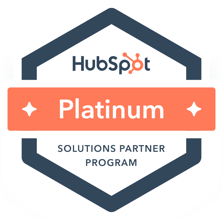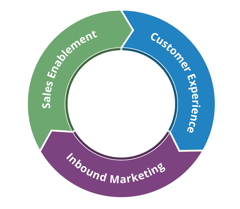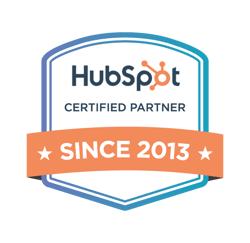The business-to-business (B2B) world is constantly evolving. More and more companies are being targeted, and more companies are targeting other companies as prospective clients. In this increasingly connected and digital world, how do you differentiate yourself from the competition? The answer is Account-Based Marketing (ABM). ABM is a focused growth strategy where Marketing and Sales collaborate to create personalized buying experiences for a mutually identified set of high-value prospects. ABM is a more focused approach to inbound marketing for specific target accounts that allows marketers to focus on better collaboration with sales, influencing more significant deals, and improving sales velocity. Here are six ways to help you get started with ABM in HubSpot.
-
Plan Your ABM Strategy
Raise awareness of ABM and coordinate all marketing and sales teams around this effort. Define your current situation on your key accounts (actions taken, difficulties encountered, roadblocks to closing deals, and more). From there, you want to define your budget and internal resources for this effort. Finally, set your objectives and KPIs for the project so you can track the effectiveness. -
Identify Your Target Accounts
Marketing and sales need to work together to identify your target accounts for the ABM program. ABM is not about reaching all of your prospects. It's about a strategic effort for your most high-value prospects. You can start by using any or all of the following criteria:
- Industry
- Annual Revenue
- Points of Contact Match Buyer Persona (or Ideal Customer Profile target)
- Potential Deal Size
- Number of Website Visits (you can track this in HubSpot)
- Number of Email Opens/Clicks (you can track this in HubSpot) -
Define the Content Journey
Analyze your previous marketing actions with your target accounts to see what has worked and what has not worked in the past. Defining your content journey will help you map and customize the content journey for your target accounts. Take an inventory of the content that your prior high-value closed accounts have read and downloaded, events or webinars they attended, how many touchpoints it took to get them to sales, and how long the complete buyer's journey took for them. From there, you can build your content journey for these prospects to include the following:- Blogs they will find helpful to answer their questions
- Downloadable content to move them through the buyer's journey, which could include case studies, whitepapers, on-demand webinars, and more
- Fill any content gaps where you see there is a part in the journey where you may have little or no content to support this target account as they go through the sales process -
Map How You Will Send Your Prospect the Defined Content
You can leverage your HubSpot workflows to automate some of this process. For example, if your average sales cycle is 30 days, you want to make sure you have touchpoints for those 30 days with content by email, follow-ups by the sales team, and maybe even a small gift if someone goes through the whole sales process and connects with a rep. Your workflow could look like this:- Day 1: Send an Email with a Link to 4 Relevant Blogs
- Day 3: Send an Email with a Link to Download a Whitepaper
- Day 6: Send a Message to the Sales Rep to Reach Out by Email
- Day 10: Send an Email with a Link to a Case Study
- Day 14: Send a Message to the Sales Rep to Call the Prospect
- Day 18: Send an Email with a Video Message from the Sales Rep
- Day 21: Send a Message to the Sales Rep to Reach Out by Phone & Email
- Day 24: Send an Email to Schedule a Demo or Consultation
- Day 27: Send a Text Message to the Prospect
- Day 30: If the Prospect Has Taken Action, Send them a Small Gift of Appreciation (You can do this through tools that integrate with HubSpot such as Postal.io)
- Day 30: If the Prospect Has Not Taken Action, Send a Final Email with Some Helpful Resources and a Note to the Sales Rep with Potential Next Steps -
Coordinate Additional Outreach Outside of Email
Email marketing is just one part of the process. You can also leverage social media to target advertising on LinkedIn, Twitter, Facebook, IG, and more to stay in front of prospects and contacts at these target organizations. You should also consider using dynamic content on your website (if your website is hosted on HubSpot) to specific content for these buyers on your home page and other target website pages you will be driving these prospects to throughout the campaign. Dynamic content is a great way to personalize the experience for these contacts, and HubSpot makes this a seamless experience within the CMS. -
Track Your Data and Optimize Future Campaigns
It's critical to track these campaigns to see how effective they are at generating interest. On the marketing side, you want to track email opens, email clicks, website page views, and conversion on your target content assets. You can also track this information in a HubSpot dashboard so you can see this information in real-time without manually pulling these metrics. Pro Tip: Create a contact property for the campaign and workflows to update this property when a target account engages. You can most easily pull this information into a dashboard. On the sales side, you want to track how many sales conversations were generated, deals initiated, and closed-won/closed-lost opportunities. You can include this on the same dashboard as your marketing initiatives to see a complete picture of the campaign.
As you can see, Account-Based Marketing can help you truly define how you communicate with your high-value accounts to make the sales process unique for each prospect. By doing this, along with personalizing the buyer’s journey and tailoring all communications, content, and campaigns to those specific accounts, you will likely see a greater return on your investment and an increase in customer loyalty because this program is highly targeted and impactful for your prospects.
If you're interested in discussing your ABM strategy and how you can leverage the tools in HubSpot to execute this, I invite you to schedule a complimentary consultation with a member of our team.


__Square.png?width=250&height=250&name=Marketing_Hub_(1)__Square.png)




.png?width=250&name=diamond-badge-color%20(1).png)
